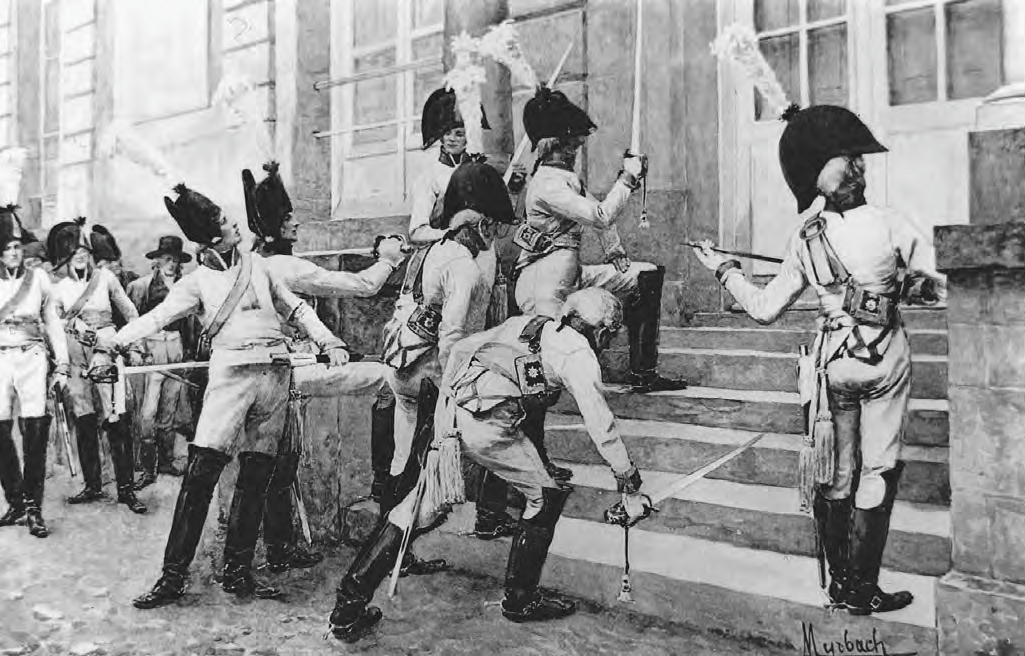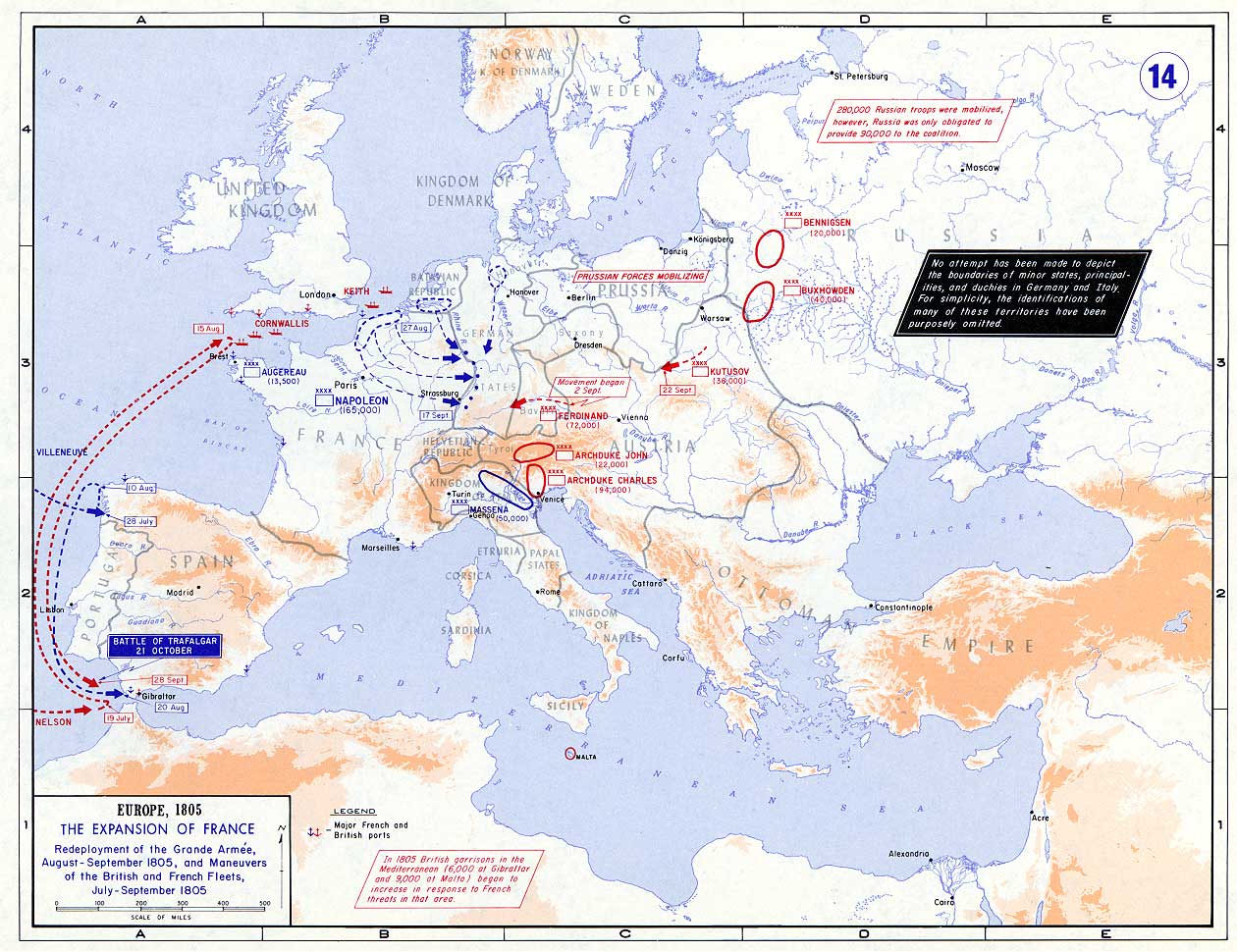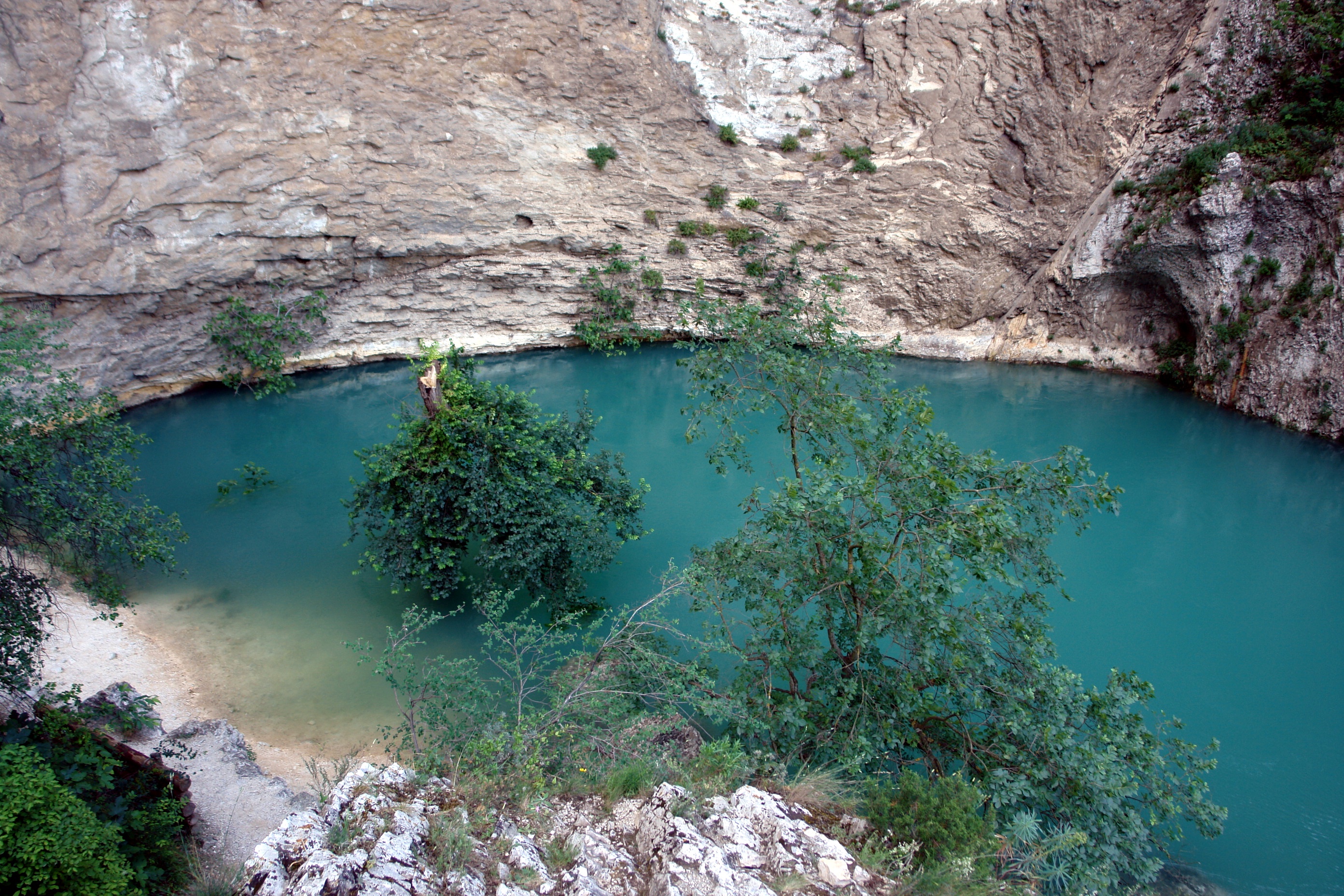|
Édouard Jean Baptiste Milhaud
Édouard Jean-Baptiste Milhaud (; 10 July 1766 – 10 December 1833) was a French politician and general. He distinguished himself throughout the French Revolutionary and Napoleonic Wars and is considered one of the best generals of cavalry of Napoleon's army. Early life and career Born in Arpajon-sur-Cère as the son of Louis Amilhaud and Marguerite Daudé, Milhaud was commissioned as an officer in 1789. During the French Revolution, Milhaud took part in the Storming of the Bastille and was elected to the National Convention (which aimed at giving France a new political constitution) and in the of Louis XVI he voted for the death of the king. He defended Jean-Paul Marat against the attacks of the Girondins. In 1793 he was sent as a commissary to the armies of the Rhine and the Ardennes where he distinguished himself in his severity and his zeal in applying revolutionary ideological principles. Sent to the Army of the Pyrenees, he was successful in aiding Dugommier in rest ... [...More Info...] [...Related Items...] OR: [Wikipedia] [Google] [Baidu] [Amazon] |
Arpajon-sur-Cère
Arpajon-sur-Cère (, literally ''Arpajon on Cère''; or just ) is a commune in the Cantal department in the Auvergne region of south-central France. Geography Arpajon-sur-Cère is located immediately to the south of Aurillac some 70 km south-east of Brive-la-Gaillarde. The town is an extension of the urban area of Aurillac. Access to the commune is by the D920 from Aurillac which continues south to Lafeuillade-en-Vézie. The D990 also goes from south of the town to Vézac in the east. The D58 comes from Giou-de-Mamou in the north-east then goes south-west from the town to the Château de Conros and joins the D617 at the south-western border of the commune. Much of the runway of Aurillac – Tronquières Airport is in the commune. A railway passes through the north of the commune but the nearest station is in Aurillac. Apart from the town there are the villages and hamlets of: *Carbonnat *Esmoles *Le Pont *Roquetorte *Douarat *Le Bousquet *Crespiat *Le Cambon *Le S ... [...More Info...] [...Related Items...] OR: [Wikipedia] [Google] [Baidu] [Amazon] |
Army Of Italy (France)
The Army of Italy () was a field army of the French Army stationed on the Italian border and used for operations in Italy itself. It is best known for its role during the French Revolutionary Wars (in which it was one of the early commands of Napoleon Bonaparte, during his Italian campaign) and Napoleonic Wars. History Bonaparte's reforms Poorly supplied (uniforms and shoes were rare), and only getting reinforcements irregularly, the Army of Italy was sometimes reduced to looting to survive. When Bonaparte arrived (he took up command on 27 March 1796), indiscipline was rife. Chouan songs were sung by the troops, and a company of the Dauphin was formed. All the while improving the supply system as much as possible, Bonaparte also reestablished discipline. He condemned officers who had cried ''Vive le roi !'', (English: "Live the king!"), dismissed the 13th regiment of hussards for indiscipline and dissolved an entire regiment when it revolted at the end of March. Purge ... [...More Info...] [...Related Items...] OR: [Wikipedia] [Google] [Baidu] [Amazon] |
Battle Of Schleiz
The Battle of Schleiz took place on 9 October 1806 in Schleiz, Germany between a Prussian-Saxon division under Bogislav Friedrich Emanuel von Tauentzien and a part of Jean-Baptiste Bernadotte's I Corps under the command of Jean-Baptiste Drouet, Comte d'Erlon. It was the first clash of the War of the Fourth Coalition, part of the Napoleonic Wars. As Emperor Napoleon I of France's advanced north through the Franconian Forest it struck the left wing of the armies belonging to the Kingdom of Prussia and the Electorate of Saxony, which were deployed on a long front. Schleiz is located 30 kilometers north of Hof and 145 kilometers southwest of Dresden at the intersection of Routes 2 and 94. At the beginning of the battle, elements of Drouet's division clashed with Tauentzien's outposts. When Tauentzien became aware of the strength of the advancing French forces, he began a tactical withdrawal of his division. Joachim Murat assumed command of the troops and began an aggressive pur ... [...More Info...] [...Related Items...] OR: [Wikipedia] [Google] [Baidu] [Amazon] |
War Of The Fourth Coalition
The War of the Fourth Coalition () was a war spanning 1806–1807 that saw a multinational coalition fight against Napoleon's First French Empire, French Empire, subsequently being defeated. The main coalition partners were Kingdom of Prussia, Prussia and Russian Empire, Russia with Electorate of Saxony, Saxony, Franco-Swedish War, Sweden, and United Kingdom of Great Britain and Ireland, Great Britain also contributing. Excluding Prussia, some members of the coalition had previously been fighting France as part of the War of the Third Coalition, Third Coalition, and there was no intervening period of general peace. On 9 October 1806, Prussia declared war on France and joined a renewed coalition, fearing the rise in French power after the defeat of Austrian Empire, Austria and establishment of the French-sponsored Confederation of the Rhine in addition to having learned of French plans to cede Prussian-desired Electorate of Hanover, Hanover to Britain in exchange for peace. Prussi ... [...More Info...] [...Related Items...] OR: [Wikipedia] [Google] [Baidu] [Amazon] |
Battle Of Austerlitz
The Battle of Austerlitz (2 December 1805/11 Frimaire An XIV French Republican calendar, FRC), also known as the Battle of the Three Emperors, was one of the most important military engagements of the Napoleonic Wars. The battle occurred near the town of Slavkov u Brna, Austerlitz in the Austrian Empire (now Slavkov u Brna in the Czech Republic). Around 158,000 troops were involved, of which around 24,000 were killed or wounded. The battle is often cited by military historians as one of Napoleon's tactical masterpieces, in the same league as other historic engagements like Hannibal's Battle of Cannae, Cannae (216 BC) or Alexander the Great's Battle of Gaugamela, Gaugamela (331 BC).Byron Farwell, Farwell p. 64. "Austerlitz is generally regarded as one of Napoleon's tactical masterpieces and has been ranked as the equal of Arbela, Cannae, and Leuthen."Trevor N. Dupuy, Dupuy p. 102 Note: Dupuy was not afraid of expressing an opinion, and he classified some of his subjects as Great ... [...More Info...] [...Related Items...] OR: [Wikipedia] [Google] [Baidu] [Amazon] |
Joachim Murat
Joachim Murat ( , also ; ; ; 25 March 1767 – 13 October 1815) was a French Army officer and statesman who served during the French Revolutionary and Napoleonic Wars. Under the French Empire he received the military titles of Marshal of the Empire and Admiral of France. He was the first Prince Murat, Grand Duke of Berg from 1806 to 1808, and King of Naples as Joachim-Napoleon () from 1808 to 1815. Born in Labastide-Fortunière in southwestern France, Murat briefly pursued a vocation in the clergy before enlisting in a cavalry regiment upon the outbreak of the French Revolution. Murat distinguished himself under the command of General Napoleon Bonaparte on 13 Vendémiaire (1795), when he seized a group of large cannons and was instrumental in suppressing the royalist insurrection in Paris. He became Napoleon's aide-de-camp and commanded the cavalry during the French campaigns in Italy and Egypt. Murat played a pivotal role in the Coup of 18 Brumaire (1799), which brough ... [...More Info...] [...Related Items...] OR: [Wikipedia] [Google] [Baidu] [Amazon] |
War Of The Third Coalition
The War of the Third Coalition () was a European conflict lasting from 1805 to 1806 and was the first conflict of the Napoleonic Wars. During the war, First French Empire, France and French client republic, its client states under Napoleon I and its ally Spain opposed an alliance, the Third Coalition, which was made up of the United Kingdom of Great Britain and Ireland, United Kingdom, the Austrian Empire, the Russian Empire, Kingdom of Naples, Naples, Kingdom of Sicily, Sicily, and Sweden. Kingdom of Prussia, Prussia remained neutral during the war. Britain had already been at war with France following the breakdown of the Treaty of Amiens, Peace of Amiens and remained the only country still at war with France after the Treaty of Pressburg (1805), Treaty of Pressburg. From 1803 to 1805, Britain stood under constant threat of a Napoleon's planned invasion of the United Kingdom, French invasion. The Royal Navy, however, assured its naval dominance at the Battle of Trafalgar in Oc ... [...More Info...] [...Related Items...] OR: [Wikipedia] [Google] [Baidu] [Amazon] |
Vaucluse
Vaucluse (; or ) is a department in the southeastern French region of Provence-Alpes-Côte d'Azur. It had a population of 561,469 as of 2019.Populations légales 2019: 84 Vaucluse INSEE The department's is . It is named after a spring, the Fontaine de Vaucluse, one of the largest karst springs in the world. The ... [...More Info...] [...Related Items...] OR: [Wikipedia] [Google] [Baidu] [Amazon] |
Army Of England
The Army of England () was a command of the French Revolutionary Army that existed from 1797 to 1800. History On 26 October 1797, the French Directory established the Army of England with the goal of invading Great Britain. By the end of the year, 40,000 men from the Army of Italy, along with 10,000 from both the Army of the Rhine and the Army of Mainz had been called to the new army, which was yet to be assembled. General Napoleon Bonaparte was appointed commander, with General Louis Desaix serving as provisional commander in Paris during Bonaparte's absence. Although destined for an invasion of Great Britain, this plan was eventually abandoned, and instead the Army of England was charged with suppressing the Chouannerie of 1799, in Western France. On 14 January 1800, it was renamed the Army of the West and the order went into effect on 17 January. Commanders-in-chief *26 October 1797 – 12 April 1798: Napoleon Bonaparte. The army not being assembled, Bonaparte kept it ... [...More Info...] [...Related Items...] OR: [Wikipedia] [Google] [Baidu] [Amazon] |
French Directory
The Directory (also called Directorate; ) was the system of government established by the Constitution of the Year III, French Constitution of 1795. It takes its name from the committee of 5 men vested with executive power. The Directory governed the French First Republic from 26 October 1795 (4 Brumaire an IV) until 10 November 1799, when it was overthrown by Napoleon Bonaparte in the Coup of 18 Brumaire and replaced by the French Consulate, Consulate. The Directory was continually at war with foreign coalitions, including Kingdom of Great Britain, Britain, Habsburg monarchy, Austria, Kingdom of Prussia, Prussia, the Kingdom of Naples, Russian Empire, Russia and the Ottoman Empire. It annexed Austrian Netherlands, Belgium and the left bank of the Rhine, while Bonaparte conquered a large part of Italy. The Directory established 29 short-lived sister republics in Italy, Helvetic Republic, Switzerland and the Batavian Republic, Netherlands. The conquered cities and states were ... [...More Info...] [...Related Items...] OR: [Wikipedia] [Google] [Baidu] [Amazon] |
Napoleon I Of France
Napoleon Bonaparte (born Napoleone di Buonaparte; 15 August 1769 – 5 May 1821), later known by his regnal name Napoleon I, was a French general and statesman who rose to prominence during the French Revolution and led Military career of Napoleon, a series of military campaigns across Europe during the French Revolutionary and Napoleonic Wars from 1796 to 1815. He led the French First Republic, French Republic as French Consulate, First Consul from 1799 to 1804, then ruled the First French Empire, French Empire as Emperor of the French from 1804 to 1814, and briefly again in 1815. He was King of Italy, King of Kingdom of Italy (Napoleonic), Italy from 1805 to 1814 and Protector of the Confederation of the Rhine, Protector of the Confederation of the Rhine from 1806 to 1813. Born on the island of Corsica to a family of Italian origin, Napoleon moved to mainland France in 1779 and was commissioned as an officer in the French Royal Army in 1785. He supported the French Rev ... [...More Info...] [...Related Items...] OR: [Wikipedia] [Google] [Baidu] [Amazon] |
18 Brumaire
The Coup of 18 Brumaire () brought Napoleon Bonaparte to power as First Consul of the French First Republic. In the view of most historians, it ended the French Revolution and would soon lead to the coronation of Napoleon as Emperor of the French. This bloodless coup d'état overthrew the Directory, replacing it with the French Consulate. This occurred on 9 November 1799, which was 18 Brumaire, Year VIII, under the short-lived French Republican calendar system. Context After Habsburg-controlled Austria declared war on France on 12 March 1799, emergency measures were adopted and the pro-war Jacobin faction, the Montagnards, triumphed in the 1799 French legislative election held in April. With Napoleon and the republic's best army engaged in the French invasion of Egypt and Syria, France suffered a series of reverses on the battlefield in the spring and summer of 1799. The Coup of 30 Prairial VII (18 June) ousted the Jacobins and left Emmanuel Joseph Sieyès, a membe ... [...More Info...] [...Related Items...] OR: [Wikipedia] [Google] [Baidu] [Amazon] |








